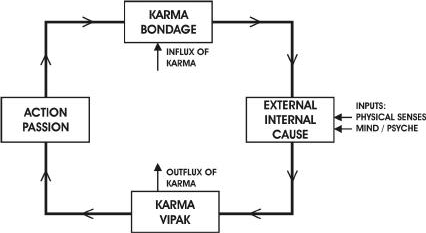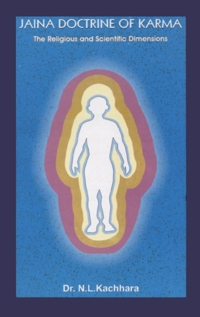We shall now revert to the question, how the Karmas are formed and bonded with the soul. Let us assume that a soul has Karma body attached to it. The past impressions on the Karma give rise to kasayas or the passions. The passions are desires carrying feelings of love and hate or attachment and aversion. There are four main types of passions - anger, pride, illusion or deceit and greed. Based on degrees the passions can be further sub classified. These passions, introduce impurities and aberrations into the soul. The abilities of the pure soul in the form of infinite knowledge, perception, etc, are diminished when passions are introduced. Thus a mundane soul has limited knowledge, perception, vitality and pleasure. The properties of the pure soul are said to be obscured by Karma. A Karma is known by the particular properly it obscures. For example the knowledge of the soul is obscured by knowledge obscuring Karma. More is the coverage less is the power of knowing of an individual and vice versa.
A living being is engaged in some kind of activity. The action may be taken by the body, speech or mind or some combination of these agencies. These actions and accompanying passions induce vibrations in the soul. The nature of vibration depends on the type of action and the magnitude of vibration depends on the degree of passion. Two things happen due to vibrations in the soul. First, the Karma body vibrates on account of the principle of resonance. Second, the vibrating soul attracts Karma varganas from the surroundings. The Karma varganas are a kind of subtle matter energy particles assumed to be present all over the cosmos, perhaps in the form of waves. The Karma varganas are agglomerates of Jaina atoms but are invisible to the eyes. An atom called parmanu, is according to Jainas the smallest indivisible indestructible, particle of matter. There is only one kind of parmanu in the universe and all other material atoms and particles are aggregates of infinitely large number of parmanus. For example, the atoms of various elements known to science are aggregates of infinite number of Jaina parmanus. The Jains believe that the parmanu has not yet been discovered by science. We shall discuss about the nature of Karma vargana later.
The Karma varganas bonding with the soul become part of Karma body and are called Karma. This Karma is a group of specific vargana that carries the impression of a particular action, which forms a part of the Karma body. How long, Karma remains in the Karma body? Each Karma has a life and after that it separates out from the Karma body. The shedding of Karma from the Karma body is known as Karma vipaka or nirjara. This will be discussed further in a later section.
The shedding of Karma induces a particular bhava or feeling in the soul. Alternatively an individual may induce some feeling in one’s self by own effort and cause the shedding of Karma. The feeling thus is the consequence of change in state of the soul. When the soul changes from state 1 to state 2 feeling originates. Conversely, the feeling can transform the soul from state 1 to state 2. This is the key for the process of emancipation of the soul.
Now consider the case when nirjara of some Karma is taking place. The state of the soul is changed and depending on the type of Karma a particular feeling is developed which in turn gives rise to some specific thoughts, and the person acts accordingly. The accompanying passions induce vibrations in the soul causing inflow of Karma varganas in the Karma body.
In this process two things happen simultaneously. First, some Karma are shed from the Karma body and second some Karma varganas are bound with the Karma body forming new Karma. Thus the Karma vipak and Karma bondage form a cyclic process as shown in fig. 1, in the same cycle there is influx and out flux of Karma. If the influx is more than out flux there is a net gain of Karma. If the out flux is more than influx a net loss of Karma takes place. Generally a person is not careful in his actions and there is a net gain of Karma. Under such circumstances a person is not able to reduce his Karma and the soul has to bear the consequences in the form of continued cycle of rebirths and suffer sorrow and misery in each birth.
A question may be asked that what is the way to reduce or completely destroy the Karma? Briefly the following ways have been suggested.
1. | Observation. Observe the events as they occur without allowing the feelings to rise. Put up with the pains and pleasures, good and bad, favourable and adverse situations with neutral attitude without reacting to them. Do not allow the emotion to rise, just know and observe the events as they happen. In the absence of feelings or passions new Karma will not be formed. |

FIG.1. The Karma Cycle
2. | Penance. By undertaking penance the emotion are purified. This causes more out flux and less influx of Karma. Whatever new Karma are formed are of good type which produce pleasure and not pain on vipaka. |
3. | Meditation. Meditation is the best way of nirjara. Using the right kind of mediation the Karmas can be destroyed. |
 Dr. N.L. Kachhara
Dr. N.L. Kachhara

